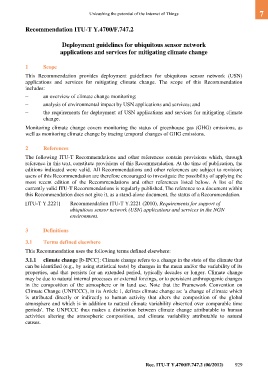Page 943 - Unleashing the potenti al of the Internet of Things
P. 943
Unleashing the potential of the Internet of Things 7
Recommendation ITU-T Y.4700/F.747.2
Deployment guidelines for ubiquitous sensor network
applications and services for mitigating climate change
1 Scope
This Recommendation provides deployment guidelines for ubiquitous sensor network (USN)
applications and services for mitigating climate change. The scope of this Recommendation
includes:
– an overview of climate change monitoring;
– analysis of environmental impact by USN applications and services; and
– the requirements for deployment of USN applications and services for mitigating climate
change.
Monitoring climate change covers monitoring the status of greenhouse gas (GHG) emissions, as
well as monitoring climate change by tracing temporal changes of GHG emissions.
2 References
The following ITU-T Recommendations and other references contain provisions which, through
reference in this text, constitute provisions of this Recommendation. At the time of publication, the
editions indicated were valid. All Recommendations and other references are subject to revision;
users of this Recommendation are therefore encouraged to investigate the possibility of applying the
most recent edition of the Recommendations and other references listed below. A list of the
currently valid ITU-T Recommendations is regularly published. The reference to a document within
this Recommendation does not give it, as a stand-alone document, the status of a Recommendation.
[ITU-T Y.2221] Recommendation ITU-T Y.2221 (2010), Requirements for support of
ubiquitous sensor network (USN) applications and services in the NGN
environment.
3 Definitions
3.1 Terms defined elsewhere
This Recommendation uses the following terms defined elsewhere:
3.1.1 climate change [b-IPCC]: Climate change refers to a change in the state of the climate that
can be identified (e.g., by using statistical tests) by changes in the mean and/or the variability of its
properties, and that persists for an extended period, typically decades or longer. Climate change
may be due to natural internal processes or external forcings, or to persistent anthropogenic changes
in the composition of the atmosphere or in land use. Note that the Framework Convention on
Climate Change (UNFCCC), in its Article 1, defines climate change as: 'a change of climate which
is attributed directly or indirectly to human activity that alters the composition of the global
atmosphere and which is in addition to natural climate variability observed over comparable time
periods'. The UNFCCC thus makes a distinction between climate change attributable to human
activities altering the atmospheric composition, and climate variability attributable to natural
causes.
Rec. ITU-T Y.4700/F.747.2 (06/2012) 929

